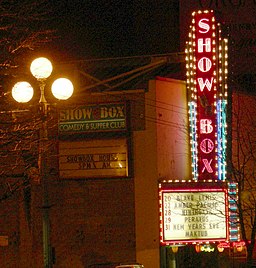
Seattle Showbox Marquee. Joe Mabel CC-BY-SA-3.0, via Wikimedia Commons
Cory Nowacky, Associate Analyst
With news that a residential tower would be replacing one of the few remaining historic music venues in Seattle, the city quickly responded with action to preserve one of Seattle’s longest standing and iconic music & entertainment venues, The Showbox. These efforts included a petition which led to a unanimous council vote on August 13th that would temporarily extend The Showbox having a home in the Pike Place Market district.
Among the outcry of supporters leading to the vote were many native Seattle musicians including Mike McCready of Pearl Jam and Duff McKagan of Guns n’ Roses. Both signed an open letter that referenced saving The Showbox due to its cultural impact from the widespread musical history with artists across all genres of music including Duke Ellington, The Ramones, Prince, and many others leaving a cultural history that will forever be engraved in the city.
With the vote, the proposed 44-story, 442-unit apartment building will be put on the shelf for the next 10 months while the city decides on a plan to allow The Showbox to continue operating. One plan includes nominating The Showbox for landmark status which would not completely thwart an attempt to demolish but may make it more difficult. A change.org petition has been created and is nearing 100,000 signatures.
While this demolishment was halted it would seem that due to the steady increase of residential development in Seattle this will not be the last time that a building with cultural impact and influence faces extinction in order to capitalize on the demand for new places to live.
With the unanimous vote, the city also lost out on $5 million for Seattle’s affordable housing fund from the developer, Omni. Was the protest of tearing down the venue worth it to the city in the long run? While it may seem like the right idea to save a cultural representation of Seattle’s history, it’s also worth pondering the long term consequences from protests like these. Housing, zoning laws, funding, and politics are amongst the variables fueling these decisions.
It would seem many of the people that are for saving the venue have let emotion sway their opinion on salvaging a venue that both they and the city have a personal history with. As there are many arguments to be made from both sides, it would be nice to see more of a discussion on the pros and cons rather than petitions from rock stars citing nothing other than well-curated opinions. While this emotion-driven response from musicians across the county is understandable, consider that the city has many other music venues waiting to paint a cultural history of their own. With limited space and laws that make it difficult to build, the city may have to consider sacrificing some of its favorite places to keep up with the housing demand that has flooded the city.





Recent Comments